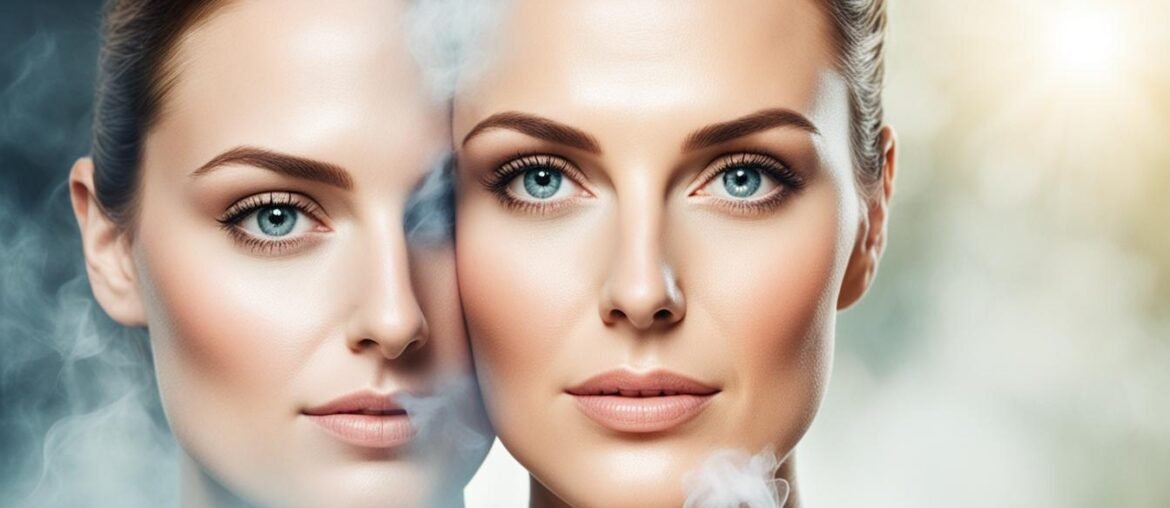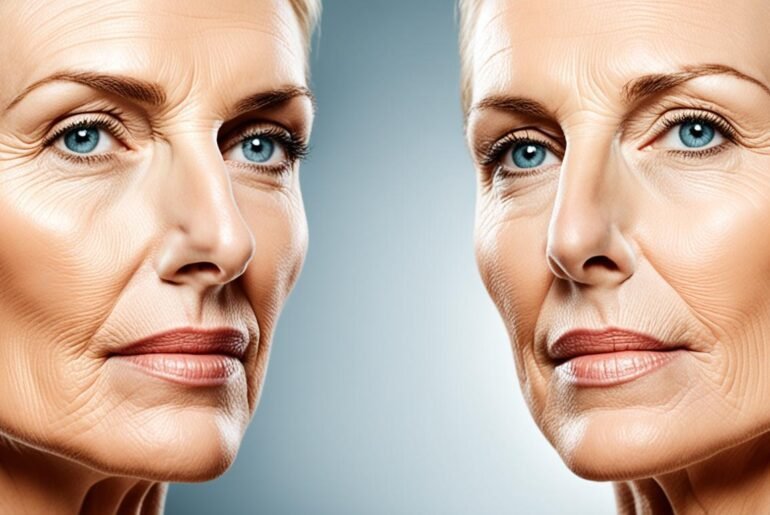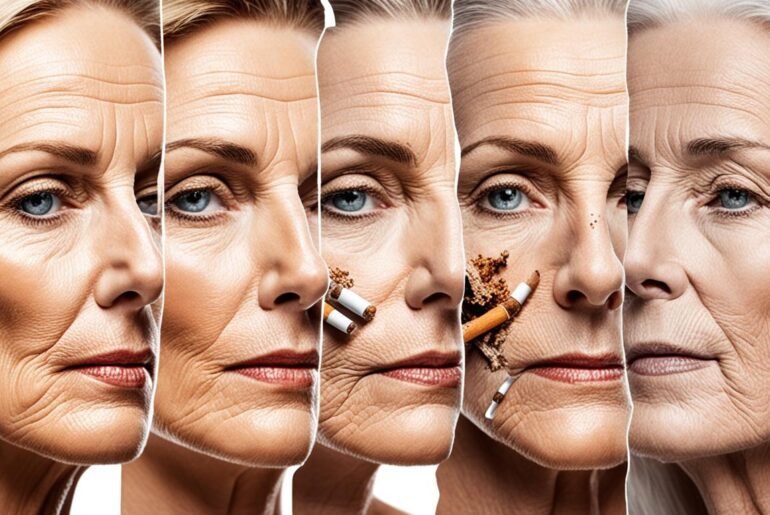Did you know that smoking can age your skin by up to 10 years? It’s true! The harmful effects of smoking go beyond your internal health, wreaking havoc on the largest organ of your body – your skin.
Smoking accelerates the aging process, leading to premature wrinkles, loss of elasticity, and skin discoloration. The chemicals in tobacco smoke not only damage the skin’s cells but also hinder its ability to repair and renew itself. This can result in a wasted appearance, sagging skin, and the development of wrinkles, such as crow’s feet and lines around the mouth.
But the impact of smoking on the skin goes even deeper. Smoking restricts blood flow to the skin, depriving it of oxygen and essential nutrients. This further contributes to the overall deterioration of skin health and appearance.
Fortunately, there is hope. By quitting smoking, you can greatly improve the health and appearance of your skin. Let’s delve deeper into the specific ways smoking affects the skin and how quitting can reverse these damaging effects.
Key Takeaways
- Smoking ages the skin by up to 10 years, resulting in premature wrinkles, loss of elasticity, and skin discoloration.
- The chemicals in tobacco smoke damage the skin’s cells and hinder its ability to repair and renew itself.
- Smoking restricts blood flow to the skin, depriving it of oxygen and essential nutrients.
- Quitting smoking can help improve the health and appearance of the skin.
Smoking and Collagen Breakdown
Smoking plays a major role in the breakdown of collagen, a protein that gives the skin its strength and elasticity. The chemicals in tobacco smoke, including nicotine, promote the production of enzymes that degrade collagen, causing the skin to sag and develop wrinkles. Smoking also reduces skin elasticity and firmness, leading to a loss of youthful appearance. These effects are more pronounced in heavy smokers and can be seen as early as the 20s or 30s.
Collagen breakdown is a significant consequence of smoking and contributes to the premature aging of the skin. Nicotine and other harmful chemicals in tobacco smoke disrupt the delicate balance of collagen production and degradation, leading to a decrease in skin firmness and elasticity. As a result, the skin loses its ability to bounce back and starts to sag.
Smoking-induced collagen breakdown is not limited to the face but affects the entire body. The arms, neck, chest, and other areas exposed to tobacco smoke also experience reduced collagen levels, resulting in sagging skin and the formation of wrinkles.
Quitting smoking can help slow down collagen breakdown and improve skin elasticity and firmness. By eliminating exposure to harmful chemicals, the body can gradually repair and rejuvenate the skin. Collagen production can be stimulated, and the appearance of wrinkles and sagging can be minimized over time.
Smoking accelerates collagen breakdown, leading to sagging skin and the formation of wrinkles. Quitting smoking is essential for preserving skin elasticity and maintaining a youthful appearance.
In addition to quitting smoking, lifestyle changes such as maintaining a healthy diet, staying hydrated, and protecting the skin from sun damage can further support collagen production and promote overall skin health. It’s never too late to quit smoking and start prioritizing your skin’s well-being.
Smoking and Skin Discoloration
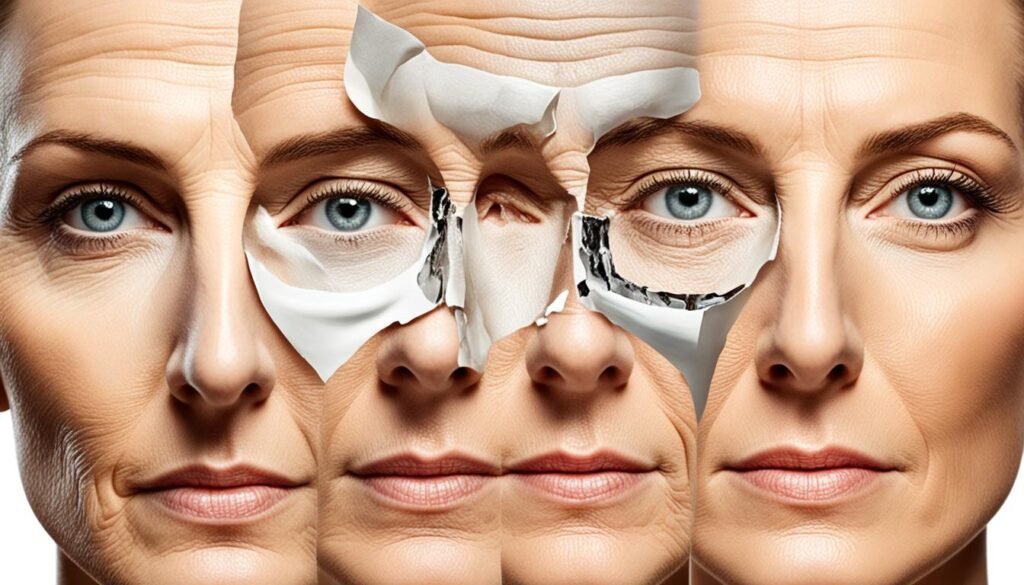
Tobacco smoke can have a profound effect on the color and tone of your skin. One of the most noticeable consequences of smoking is the development of skin discoloration, which can give the complexion a grayish, wasted appearance.
When you smoke, the harmful chemicals in tobacco smoke restrict blood flow to the skin, resulting in reduced oxygen and nutrient supply to the cells. This diminished blood flow can lead to uneven skin tone and a pale complexion.
Furthermore, the effects of smoking on skin color are not limited to older individuals. Even younger smokers can experience changes in their skin tone, and these effects become more pronounced over time with long-term smoking.
However, it’s important to note that quitting smoking can make a significant difference in improving skin color and restoring a healthier complexion. By quitting smoking, you allow your skin to receive proper blood flow, oxygen, and essential nutrients, leading to a rebalance in skin tone and a restoration of its natural radiance.
Smoking and Wrinkles
Smoking is a significant risk factor for the development of wrinkles, especially on the face. The repetitive motions of smoking, such as squinting and puckering the lips, contribute to the formation of wrinkles around the eyes (crow’s feet) and mouth. The harmful chemicals in tobacco smoke also accelerate the breakdown of collagen and elastin, leading to the formation of deeper wrinkles.
“The repetitive facial movements involved in smoking, like squinting and pursing the lips, can contribute to the development of wrinkles,” says Dr. Sarah Thompson, a renowned dermatologist. “Additionally, the toxic components of tobacco smoke can further damage the skin’s support structures, such as collagen and elastin, resulting in more pronounced wrinkles.”
Smokers are more likely to have facial wrinkles at an earlier age compared to non-smokers. The effects of smoking on the skin are cumulative, meaning that the longer an individual smokes, the more visible and extensive the wrinkles become. Quitting smoking can help reduce the appearance of wrinkles and prevent the formation of new ones.
The Impact on Lip Wrinkles
Smoking is also associated with the development of wrinkles around the lips. The repeated actions of puckering and inhaling can lead to the formation of vertical lines, commonly referred to as “smoker’s lines.” These lip wrinkles can be particularly challenging to treat and may require interventions such as dermal fillers or laser resurfacing.
Preventing Crow’s Feet
Quitting smoking is essential in preventing the development of crow’s feet, which are the wrinkles at the outer corners of the eyes. These lines are exacerbated by the repetitive squinting motion while smoking and are accompanied by the breakdown of collagen and elastin.
Expert Insights on Smoking and Wrinkles
“Smoking speeds up the aging process and contributes to the development of wrinkles. The toxic substances in tobacco smoke damage the skin’s structural proteins and reduce blood flow, making the skin appear older and promoting the formation of wrinkles,” explains Dr. Emily Collins, a leading dermatologist. “Quitting smoking is one of the most effective ways to improve the appearance of the skin and slow down the aging process.”
By quitting smoking, individuals can take a significant step towards reducing the appearance of wrinkles and achieving smoother and more youthful-looking skin.
Smoking and Skin Elasticity
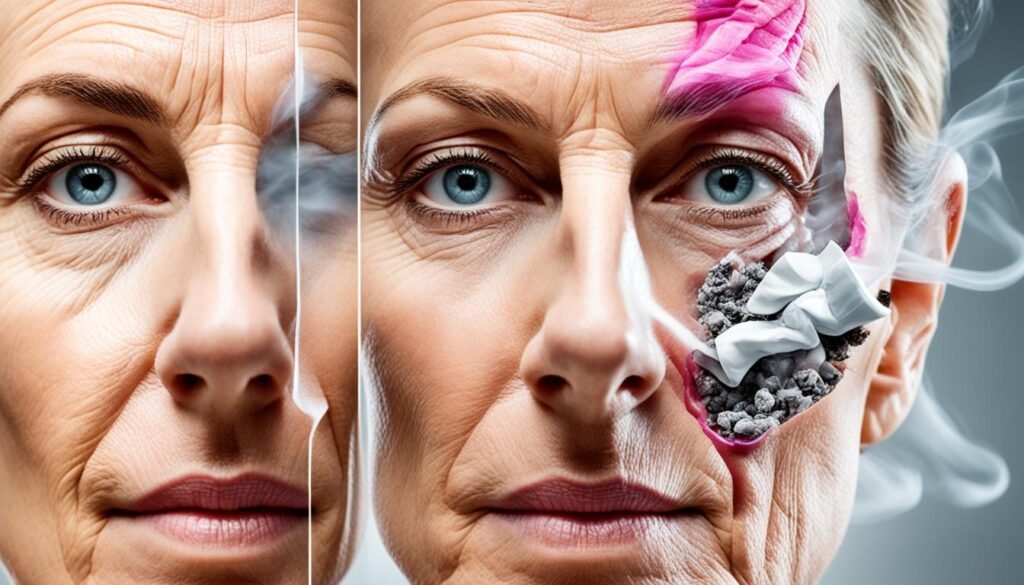
Smoking has a negative impact on the elasticity of the skin. The harmful chemicals in tobacco smoke impair the production and function of collagen and elastin, which are vital proteins responsible for maintaining skin elasticity and tightness.
This impairment of collagen and elastin leads to a loss of skin’s natural elasticity and firmness, resulting in loose and sagging skin. As a consequence, smokers are more prone to developing a prematurely aged and less youthful appearance.
To restore skin elasticity and achieve a tighter and firmer complexion, quitting smoking is crucial. By eliminating tobacco smoke from their lifestyle, individuals can help improve the production and effectiveness of collagen and elastin, promoting healthier skin.
Quitting smoking not only benefits the appearance of the skin but also contributes to overall skin health and vitality.
Smoking and Wound Healing
Smoking has a detrimental impact on wound healing and significantly increases the risk of complications. The chemicals present in tobacco smoke restrict the blood flow to the skin, reducing the supply of oxygen and essential nutrients necessary for proper healing. This impaired blood circulation can lead to delayed wound healing, wound separation, and an increased risk of infection.
Furthermore, smoking negatively affects the immune response of the body, making it more susceptible to infections and further jeopardizing the healing process. Surgical complications, such as poor outcomes and increased risks during and after surgery, are also more prevalent in smokers.
To mitigate these risks, it is crucial for individuals to quit smoking before undergoing surgical procedures. Quitting smoking enhances wound healing by restoring proper blood flow, facilitating the delivery of essential nutrients, and supporting the body’s immune response.
Here is an example table that illustrates the impact of smoking on wound healing:
| Complications | Smokers | Non-smokers |
|---|---|---|
| Delayed wound healing | Higher risk | Lower risk |
| Wound separation | More common | Less common |
| Infection risk | Increased | Decreased |
By quitting smoking, individuals can greatly improve their chances of successful wound healing, reduce the risk of complications, and enhance their overall surgical outcomes.
Smoking and Skin Diseases
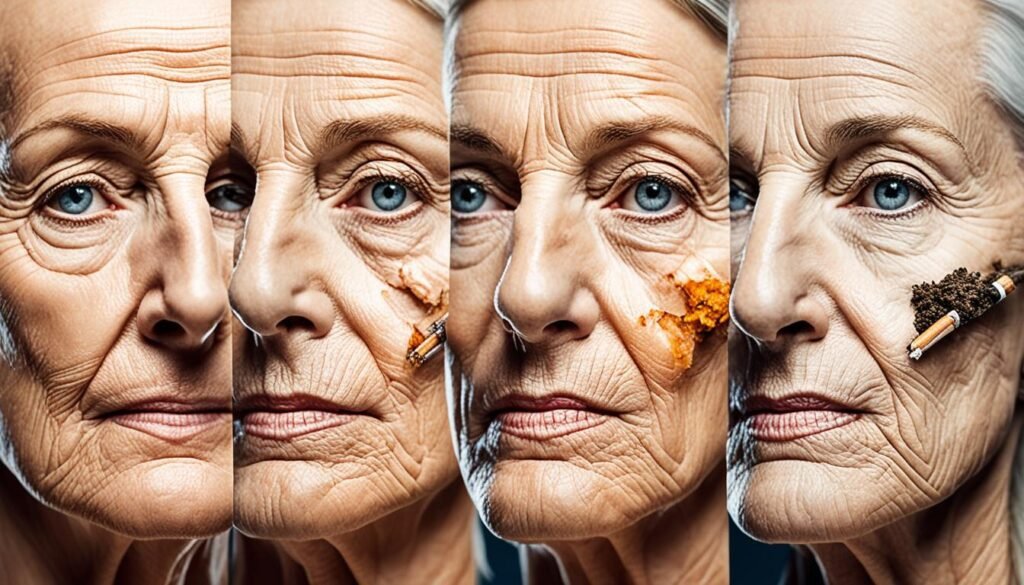
Smoking is widely recognized as a risk factor for a range of skin diseases, including psoriasis, palmoplantar pustulosis, acne, and eczema. Extensive research has established a clear connection between smoking and the development or exacerbation of these conditions. Smokers not only face an increased risk of developing these skin diseases but also experience more severe symptoms and often have a more challenging response to treatment.
Let’s take a closer look at how smoking impacts these specific skin diseases:
Psoriasis
Psoriasis is a chronic autoimmune condition characterized by the rapid buildup of skin cells, resulting in itchy, painful, and scaly patches. Studies have shown that smoking significantly increases the risk of developing psoriasis, and smokers with existing psoriasis tend to have more severe symptoms and a more challenging course of treatment.
Palmoplantar Pustulosis
Palmoplantar pustulosis is a chronic skin condition that primarily affects the palms of the hands and soles of the feet, leading to painful pustules and patches. Research has found a strong association between smoking and palmoplantar pustulosis, with smokers being more likely to develop this condition. Smokers with palmoplantar pustulosis also tend to have more severe symptoms and a lower response to treatment.
Acne
Acne is a common skin condition characterized by the presence of pimples, blackheads, and whiteheads, usually occurring during adolescence. While the direct relationship between smoking and acne is still being studied, evidence suggests that smoking can worsen existing acne and prolong its duration. The toxic chemicals in tobacco smoke may contribute to increased inflammation and impaired healing, leading to more stubborn and severe acne.
Eczema
Eczema, also known as atopic dermatitis, is a chronic inflammatory skin condition characterized by dry, itchy, and red patches. Smoking has been identified as a risk factor for developing eczema, particularly in adults. Smokers with eczema may experience more frequent flare-ups and a longer duration of symptoms compared to non-smokers.
To minimize the impact of smoking on these skin diseases, quitting smoking is crucial. Quitting can lead to a reduction in symptoms, improved treatment response, and an overall better quality of life for individuals affected by these conditions.
| Skin Disease | Association with Smoking | Impact on Symptoms | Treatment Response |
|---|---|---|---|
| Psoriasis | Increased risk | More severe | Challenging |
| Palmoplantar Pustulosis | Strong association | More severe | Lower response |
| Acne | Possible worsening | Prolonged duration | N/A |
| Eczema | Increased risk | More frequent flare-ups | N/A |
Smoking and Weight Gain
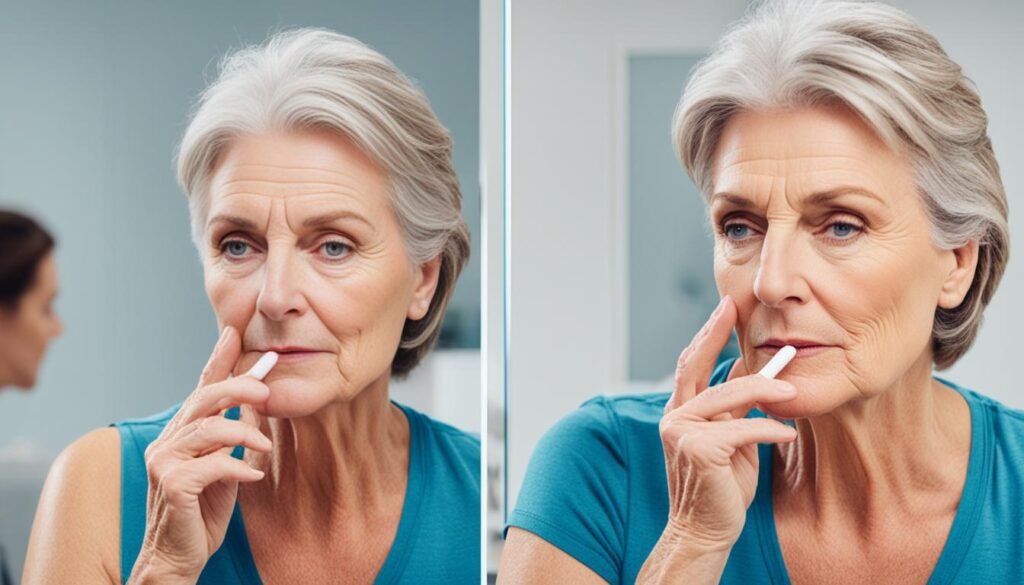
Quitting smoking is often associated with weight gain. Many smokers use cigarettes as a way to suppress appetite and maintain weight control. When they quit smoking, they may experience increased appetite and changes in metabolism, leading to weight gain. The risk of weight gain after quitting smoking is influenced by factors such as age, socioeconomic status, and initial body weight. However, the benefits of quitting smoking far outweigh the modest weight gain experienced by many individuals.
Factors Contributing to Weight Gain After Quitting Smoking
When smokers quit, they may experience certain physiological and behavioral changes that can lead to weight gain. Here are some factors that contribute to weight gain after quitting smoking:
- Increased appetite: Nicotine, the addictive substance in cigarettes, acts as an appetite suppressant. When smokers quit, they may feel hungrier than usual and eat more frequently.
- Changes in metabolism: Smoking can increase metabolism, and quitting smoking may result in a temporary decrease in metabolic rate. This can lead to fewer calories burned and an increased likelihood of weight gain.
- Emotional eating: Smoking often serves as a coping mechanism for stress and emotions. When smokers quit, they may turn to food as a substitute, leading to emotional eating and potential weight gain.
- Replacement behaviors: Some individuals may replace cigarettes with snacks or sweets, leading to an increase in calorie intake. This can contribute to weight gain if not managed properly.
Managing Weight After Quitting Smoking
While weight gain after quitting smoking is common, there are strategies to manage it effectively. Here are some tips to help individuals maintain a healthy weight after quitting:
- Focus on healthy eating: Opt for nutrient-dense foods such as fruits, vegetables, whole grains, and lean proteins. These foods provide essential nutrients while helping to satisfy hunger.
- Be mindful of portion sizes: Pay attention to portion sizes to avoid overeating. Use smaller plates and bowls to control serving sizes and avoid eating until excessively full.
- Engage in regular physical activity: Incorporate regular exercise into your routine to burn calories and maintain weight. Aim for at least 150 minutes of moderate-intensity aerobic activity per week.
- Find alternative coping mechanisms: Replace smoking with healthier coping mechanisms such as deep breathing exercises, meditation, or engaging in hobbies and activities that provide stress relief.
- Seek support: Join a support group or seek help from healthcare professionals who specialize in smoking cessation and weight management. They can provide guidance and support throughout the quitting process.
Quitting smoking is a positive step towards better health, even if it comes with some weight gain. Remember that weight gain can be managed through healthy lifestyle choices and support systems. The long-term benefits of quitting smoking far outweigh the temporary weight gain.
It’s important to establish a balance between quitting smoking and weight management. While weight gain may occur, the positive impact on overall health is significant. Don’t let the fear of gaining weight deter you from quitting smoking. With the right strategies and support, you can successfully manage your weight and enjoy the many benefits of a smoke-free life.
Smoking and Oral Health

Smoking can have detrimental effects on your oral health, impacting not only the appearance of your teeth but also the health of your gums and the success of dental treatments. It’s important to understand the impact of smoking on your oral cavity and take steps to improve your oral health if you are a smoker.
Smoking’s Impact on Teeth and Gums
One of the noticeable effects of smoking on oral health is tooth staining. The tar and nicotine found in cigarettes can cause yellow or brown discoloration of the teeth, which can be difficult to remove with regular brushing.
Smoking also increases the risk of developing periodontal disease, a condition that affects the gums and supporting structures of the teeth. Periodontal disease is characterized by gum inflammation, gum recession, and eventual tooth loss. The harmful chemicals in tobacco smoke can damage the gum tissues and impair the body’s natural ability to fight off infection, making smokers more susceptible to gum disease.
Smoking and Periodontitis
Periodontitis, an advanced stage of periodontal disease, occurs when bacteria in dental plaque cause the gums to become infected and inflamed. Smoking can exacerbate this condition, as it lowers the body’s ability to fight off the infection and slows down the healing process. Smokers with periodontitis may experience more severe symptoms and a faster progression of the disease compared to non-smokers.
Smoking and Dental Implants
If you’re considering dental implants to replace missing teeth, it’s crucial to quit smoking. Smoking has been shown to increase the risk of complications and implant failure. The chemicals in tobacco smoke reduce blood flow to the gums and bone, impeding the healing process and negatively affecting the integration of implants with the surrounding tissues. Smokers who undergo dental implant surgery may experience a higher rate of implant failure and more frequent complications.
Quitting smoking is essential for improving oral health and reducing the risk of periodontal disease and complications after dental procedures. By quitting smoking, you can promote healthier teeth and gums and increase the success rate of dental treatments.
| Effects of Smoking on Oral Health | |
|---|---|
| 1 | Yellow or brown tooth staining |
| 2 | Increased risk of periodontal disease |
| 3 | Impaired wound healing in the mouth |
| 4 | Higher risk of dental implant complications and failure |
Sources:
- “Effects of Smoking on Oral Health.” American Dental Association. https://www.ada.org/en/member-center/oral-health-topics/smoking-and-tobacco.
- “Smoking and Periodontal Disease.” Centers for Disease Control and Prevention. https://www.cdc.gov/tobacco/campaign/tips/diseases/periodontal-gum-disease.html.
- “Dental implants: Complications.” Mayo Clinic. https://www.mayoclinic.org/tests-procedures/dental-implant-surgery/about/pac-20384622.
Smoking and Skin Cancer
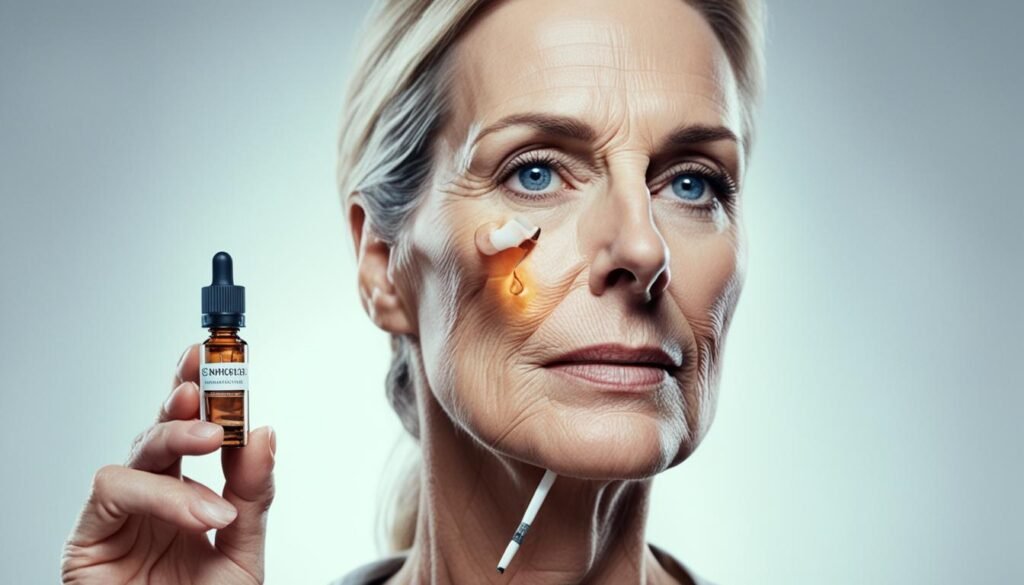
Smoking is a known risk factor for the development of skin cancer, including squamous cell carcinoma and melanoma. The harmful chemicals present in tobacco smoke can damage the DNA of skin cells, increasing the risk of abnormal cell growth and the formation of cancerous lesions.
Smokers are particularly susceptible to squamous cell carcinoma, a type of skin cancer that originates in the squamous cells. These cells are found in the outermost layer of the skin and are responsible for its structure and protection. Smoking increases the risk of squamous cell carcinoma by compromising the skin’s ability to repair and regenerate itself.
Additionally, smoking has been associated with an increased risk of melanoma, the most aggressive form of skin cancer. Melanoma arises from the pigment-producing cells (melanocytes) and can spread rapidly to other parts of the body if not detected and treated early.
By quitting smoking, individuals can reduce their risk of developing skin cancer and improve their overall skin health. It is never too late to quit smoking and reap the benefits of a smoke-free life.
| Type of Skin Cancer | Risk Associated with Smoking |
|---|---|
| Squamous Cell Carcinoma | Increased risk due to compromised skin repair mechanisms |
| Melanoma | Higher likelihood of developing aggressive melanoma |
Smoking and Other Health Effects

Smoking has far-reaching consequences for overall health, extending beyond the detrimental impact on the skin. Let’s explore some of the additional health effects associated with smoking.
1. Smoking’s Impact on Bones
Smoking increases the risk of osteoporosis, a condition characterized by weak and brittle bones. The harmful chemicals in tobacco smoke interfere with the body’s ability to absorb calcium and impair bone regeneration. As a result, smokers are more prone to fractures and have a higher likelihood of developing osteoporosis compared to non-smokers.
2. Smoking and Heart Disease
Smoking is a major risk factor for heart disease. The toxic components in tobacco smoke damage the lining of the blood vessels, leading to the formation of plaques and narrowing of the arteries. This increases the risk of heart attacks, strokes, and other cardiovascular complications. Quitting smoking can significantly reduce the risk of heart disease and promote heart health.
3. Smoking and Lung Function
Smoking impairs lung function and increases the risk of respiratory conditions such as chronic bronchitis and chronic obstructive pulmonary disease (COPD). The toxins in tobacco smoke irritate and inflame the airways, causing long-term damage and leading to breathing difficulties. Quitting smoking is essential for preserving lung health and maintaining optimal respiratory function.
4. Smoking and Fertility
Both men and women who smoke may experience fertility issues. In men, smoking can reduce sperm count, motility, and overall quality, making it more challenging to conceive. Smoking in women can interfere with the reproductive system and disrupt hormonal balance, leading to difficulties in getting pregnant. Quitting smoking is crucial for improving fertility outcomes and increasing the chances of successful conception.
5. Smoking and Menopause
Women who smoke tend to reach menopause earlier, on average, than non-smokers. Smoking accelerates the decline in ovarian function and depletes the egg supply in women, leading to premature menopause. Early menopause is associated with various health risks, including an increased risk of osteoporosis and heart disease. Quitting smoking can help delay the onset of menopause and mitigate these potential health complications.
| Health Effect | Description |
|---|---|
| Smoking’s Impact on Bones | Increased risk of osteoporosis, weakens bones, and fractures. |
| Smoking and Heart Disease | Elevated risk of heart attacks, strokes, and other cardiovascular complications. |
| Smoking and Lung Function | Impaired lung function, higher susceptibility to chronic bronchitis and COPD. |
| Smoking and Fertility | Reduced fertility in both men and women, challenges in conceiving. |
| Smoking and Menopause | Early onset of menopause in women, increased risk of health complications. |
Quitting smoking is the best course of action to reduce these health risks and improve overall well-being. By breaking free from smoking, individuals can safeguard their bones, protect their heart, maintain optimal lung function, enhance fertility outcomes, and delay the onset of menopause.
Conclusion
Smoking has a detrimental impact on the appearance and health of the skin. It accelerates the aging process, leading to wrinkles, sagging skin, and discoloration. The harmful chemicals in tobacco smoke impair collagen production, reduce skin elasticity, and impair wound healing. This increases the risk of various skin diseases, oral health problems, and skin cancer.
Quitting smoking is crucial for maintaining youthful skin and overall health. It can help improve skin texture, reduce wrinkles, and prevent further damage. By quitting smoking, individuals can significantly improve their skin’s appearance and reduce the risk of various health complications. Taking this step towards a smoke-free life can have a profound impact on not only the quality of your skin but also your overall well-being.
Make the decision to quit smoking today and take control of your skin’s health. With determination, support, and the right resources, you can achieve a healthier, more youthful complexion. Remember, the journey may not always be easy, but the long-term benefits are well worth it. Your skin will thank you for it, and so will your entire body.
FAQ
What is the impact of smoking on skin’s youthful appearance?
Smoking accelerates the aging process, leading to premature wrinkles, loss of elasticity, and skin discoloration. It can result in a wasted appearance, sagging skin, and the development of wrinkles.
How does smoking affect collagen breakdown?
The chemicals in tobacco smoke promote the production of enzymes that degrade collagen, causing the skin to sag and develop wrinkles. Smoking also reduces skin elasticity and firmness.
Does smoking lead to skin discoloration?
Yes, smoking restricts blood flow to the skin, resulting in reduced oxygen and nutrient supply, which can lead to uneven skin tone and a pale complexion.
Does smoking contribute to the formation of wrinkles?
Yes, the repetitive motions of smoking, such as squinting and puckering the lips, contribute to the formation of wrinkles around the eyes and mouth. Smoking also accelerates the breakdown of collagen and elastin, leading to deeper wrinkles.
How does smoking affect skin elasticity?
Smoking impairs the production and function of collagen and elastin, essential proteins that maintain skin elasticity and tightness. This can result in loose and sagging skin.
Does smoking impair wound healing?
Yes, smoking restricts blood flow to the skin, reducing the oxygen and nutrient supply needed for proper healing. It can lead to delayed wound healing, increased risk of infection, and poor outcomes after surgery.
Are there any skin diseases associated with smoking?
Yes, smoking is associated with various skin diseases, including psoriasis, palmoplantar pustulosis, acne, and eczema. Smokers are more likely to have severe symptoms and a more challenging response to treatment.
Is weight gain common after quitting smoking?
Yes, quitting smoking can lead to weight gain as many smokers use cigarettes to suppress appetite. However, the benefits of quitting smoking far outweigh the modest weight gain.
How does smoking affect oral health?
Smoking can stain teeth, cause bad breath, and increase the risk of periodontal disease. It also impairs wound healing in the mouth and increases the risk of complications after dental procedures.
Is smoking a risk factor for skin cancer?
Yes, smoking is an independent risk factor for the development of skin cancer, particularly squamous cell carcinoma. The chemicals in tobacco smoke can damage the DNA of skin cells and increase the risk of abnormal cell growth.
What are the other health effects of smoking?
Smoking increases the risk of osteoporosis, heart disease, reduces lung function, impairs fertility, and can lead to early menopause in women. Quitting smoking can significantly reduce these risks and improve overall well-being.

